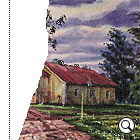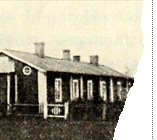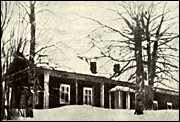
 It
has long been thought that Hövelö, in Paltaniemi, was where the manuscript
of the Kalevala was actually created. Lönnrot did work on the manuscript
there; in fact, it was his home for those months in 1834 when the Kalevala
took shape. It is a rather different question, however, how much time
Lönnrot actually spent in Hövelö in what was an intensive period of his
life.
It
has long been thought that Hövelö, in Paltaniemi, was where the manuscript
of the Kalevala was actually created. Lönnrot did work on the manuscript
there; in fact, it was his home for those months in 1834 when the Kalevala
took shape. It is a rather different question, however, how much time
Lönnrot actually spent in Hövelö in what was an intensive period of his
life.
Lönnrot's fifth field trip - a crucial one for the content of the Kalevala - took place in April of 1834. Almost immediately upon returning to Kajaani from the trip, Lönnrot took two months' leave (8 May - 23 July) to go to Helsinki for the express purpose of working on the epic. However, he had only completed a scant third of the work before he had to return to his station in Kajaani at the end of July. After two months of leave, he had a backlog of inspection trips to carry out and set himself an ambitious schedule to discharge these duties. He completed all of his normal rounds in the district, taking the manuscript with him wherever he went and working on it whenever circumstances allowed.
The original manuscript of the Kalevala comprises three notebooks. Lönnrot signed the first of these on 29 September, soon after returning from a vaccination trip to Ristijärvi, Hyrynsalmi, Suomussalmi, and Puolanka. Following that trip, he set out by boat along Lake Oulujärvi to Pyykkölä, Mananmansalo and Jaalanka. Document showing bills of Lönnrot´s travel expenses.
Next his duties took him to Murtomäki, Saaresmäki, Säräisniemi and Rokua, and, somewhat later on a second inspection trip, to Paltamo, Melalahti and Kivesjärvi. On 20 October, Lönnrot completed the second of the three books making up the manuscript. It, too, was signed in Kajaani, but much of the work that went into it was clearly done not only in Hövelö but also in the western parts of Kainuu.
As soon as the second book had been completed, Lönnrot left for Sotkamo and Kuhmo to administer vaccinations. His itinerary was the following: Kajaani - Kuluntalahti - Sotkamo - Kuhmoniemi - Lentiira - Kuumu - Pajakka - Kuhmoniemi - Häkkilä - Tuhkiniem i- Kähkölä (in Lammasperä) - the Malinen house - Kesseli - the Havukka house (on the Russian border) - Kolvasjärvi - Repola - Kolvasjärvi - Kesseli - Korkiavaara - Selkävaara - Malinen - Lammasperä - Kuhmoniem i- Kajaani. Lönnrot thus crossed over into Russia - his stop in Repola - during his trip. It was during this journey that Lönnrot finished the remaining third of the Kalevala, for he signed the third book on 11 November in Kuhmo. At that point, the epic - complete save a foreword and minor revisions - was 11 688 lines in length; the final version was to comprise 12 078 lines.

![]() At
the end of 1834, Lönnrot sold his house in Hövelö and bought
the Partala-Polvila farm in Paltamo, three kilometers from Kajaani, for
himself and his parents. He also bought postmaster Montgomery's house
in Kajaani but only temporarily as a favor to Montgomery, who was moving
away and had not been able to sell the house. Lönnrot lived at Hövelö
through the end of March 1835, using the time to put the finishing touches
on the manuscript and write the foreword, finishing the latter on 28 February
1835.
At
the end of 1834, Lönnrot sold his house in Hövelö and bought
the Partala-Polvila farm in Paltamo, three kilometers from Kajaani, for
himself and his parents. He also bought postmaster Montgomery's house
in Kajaani but only temporarily as a favor to Montgomery, who was moving
away and had not been able to sell the house. Lönnrot lived at Hövelö
through the end of March 1835, using the time to put the finishing touches
on the manuscript and write the foreword, finishing the latter on 28 February
1835.
On balance, all of Kainuu can be regraded as the birthplace of the Kalevala. Lönnrot recorded most of the poems, and the best ones, in Viena, but the final manuscript took shape elsewhere - in Helsinki and every municipality in Kainuu.
